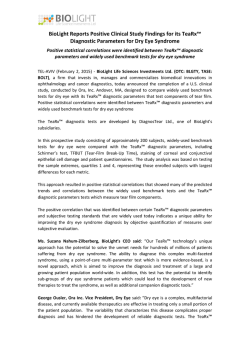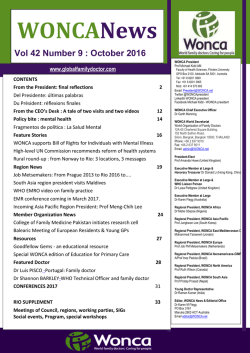
Prevención cuaternaria y ejemplo de aplicación con la CIAP
Actividad Preparatoria del Seminario de Prevención Cuaternaria del 4° Congreso Iberoamericano de Medicina Familiar y Comunitaria, Wonca Ibemeroamericana, CIMF http://www.montevideo2015wonca-cimf.org/ Seminar Buenos Aires, 12 de Marzo 2015. 18h P4 y CIAP-2 Marc Jamoulle Medico de familia, Health data management specialist Espace Temps maison de santé, Charleroi , Belgica Doctorando, Département de médecine générale, ULG [email protected] P4 Prevención cuaternaria CIAP-2 Clasificación Internacional de Atención Primaria, segunda edición Nacimiento de la prevención clínica Clark EG. Br J Vener Dis. 1954;30(4):191–197 Prevenir la enfermedad variable continua línea de tiempo 3 Organización del sistema de salud variable discreta Last JM, Spasoff RA, Harri SS. A Dictionary of Epidemiology. 1988. Bentzen N. Wonca glossary for general/family practice 1995 Bentzen N. Wonca Dictionary of General/Family Practice. 2003. 4 Una tabla de contingencia: el médico frente a paciente Jamoulle M. Information et informatisation en médecine générale.1986 4 áreas están delimitadas 6 Propuesta al WICC 1995 Jamoulle M, Roland M. Quaternary prevention. In: WICC annual workshop. Hong Kong. 1995. Aceptación por WICC 1999 WICC meeting at DUKE, Durham 1999 Publicación por el WICC 2003 Bentzen N. Wonca Dictionary of General/Family Practice. 2003. 7 circularidad 8 sobretamizage sobreinformación sobrediagnóstico/ sobretratamiento sobremedicalisación 9 De la Prevención Cuaternaria a la Actitud Cuaternaria El término prevención ha desaparecido ¿Qué observas? Y obtenemos una descripción del ejercicio de Medicina Familiar incluida la prevención de la propia 11 medicina una consulta, varios niveles de problemas El concepto Cuaternario demuestra que la relación, el tiempo y la polimorbilidad son los instrumentos de cada día de los Médicos de Familia Decirlo, bien Probarlo, mejor Vemos como clasificaciones pueden ayudarnos Primary care provider could be source of overproduction in health care, asking more process, images and biology leading to overmedicalisation They are often afraid to « miss » something important, pushed forward by the anxiety of the patient Other reasons are defensive medicine or the competition with other colleagues This is called « diagnostic errors » or « missed diagnosis » by people who are not aware of the specificity of primary care Example : a recent claim Diagnostic errors are estimated to affect about 12 million Americans each year in ambulatory care settings alone. Many studies, including those involving record reviews and malpractice claims, have shown that common conditions (ie, not just rare or difficult cases) are often missed, leading to patient harm. Healthcare organisations do not have the tools and strategies to measure diagnostic safety and most have not integrated diagnostic error into their existing patient safety programmes. To ensure diagnostic safety, we recently developed a multifaceted framework to advance the science of measuring diagnostic errors (Safer Dx framework: Singh H, Sittig DF. BMJ Qual Saf. 2015;24:103–10 Typical top bottom approach) The answer The few times over the course of my career that I care for a patient with the first manifestations of a rare disease, I should not be vilified for making a delayed diagnosis This kind of thinking undermines primary care. In fact, the whole concept of delayed diagnosis in primary care needs to be severely curtailed, or my preference would be to abandon it. Family physicians and general practitioners deliver better care at a lower cost than all other physicians precisely because we are more comfortable with uncertainty and are comfortable applying overall probabilities to individual patient care situations. Richard Ashley Young, M.D. Dept. Family Medicine John Peter Smith Hospital. Fort Worth. USA Young R A. BMJ Qual Saf [Internet]. 2015;(March):4091. comment Primary care has always struggled with the problem of high uncertainty due to low diagnostic certainty – The ICPC classification of disease has formalised lots of his insights, i.e. much of the complaints presenting to primary care are of a symptom or group of symptom nature that do not end up to a firm diagnosis, and thus "clear-cut" treatment approach. Joachim Sturmberg < A/Professor of General Practice Sydney Area, Australia - comment Until the public ( and policy -makers) understand that we cannot guarantee certainty, the excessive testings ( and unnecessary treatments) will continue, I am afraid. Ben Djulbegovic MD, PHD Professor of Medicine and Oncology University of South Florida USA The Stacey matrix is close to P4 Chaos Making data with ICPC helps the doctors Most of the time we are managing to escape what's Stacey calls Chaos in his diagram The use of data in Primary Care speaks about facts The use of ICPC in Primary Care allows to establish facts Numerous studies in PC show that delayed diagnosis is not the problem. Main issues in primary care are spontaneously disappearing symptom diagnosis and multimorbidity Fine knowledge of what’s going on in PC is needed and implies an effort in information gathering No hay en la tierra una sola página, una sola palabra, que lo que sea, ya que todos postulan el universo, cuyo más notorio atributo es la complejidad. J L Borges El informe de Brodie , prólogo Family doctor knowledge about a patient Hélio Oiticica, Metaesquema, 1958 MALBA, Buenos Aires What about data in PC in Argentine? Nearly 20 years after its completion in 1996, I have the chance to receive the seminal work of Ricardo La Valle I am interested to know how family doctor in Argentine are gathering data and to gather more publication on this issue. I urge primary care organisators to support the work of the Wonca International Classification Committee (WICC) to consider to take a licence for ICPC-2 and to send a second observer to our group WICC has endorsed P4 and is currently working on ICPC-3 ph3c.org References used in this presentation 1. Jamoulle M. Quaternary prevention, an answer of family doctors to overmedicalization. Int J Heal policy Manag [Internet]. 2015 Feb [cited 2015 Feb 26];4(2):61–4. Available from: http://www.pubmedcentral.nih.gov/articlerender.fcgi?artid=4322627&tool=pmcentrez&renderty pe=abstract 2. The Satcey matrix ; http://www.gptraining.net/training/communication_skills/consultation/equipoise/complexity/stacey.htm 3. Young R a. Bad assumptions on primary care diagnostic errors. Response to: “Advancing the science of measurement of diagnostic errors in healthcare: the Safer Dx framework” by Singh and Sittig. BMJ Qual Saf [Internet]. 2015;(March):4091. Available from: http://qualitysafety.bmj.com/lookup/doi/10.1136/bmjqs-2015-004091 4. Singh H, Sittig DF. Advancing the science of measurement of diagnostic errors in healthcare: the Safer Dx framework. BMJ Qual Saf [Internet]. 2015;24:103–10. Available from: http://qualitysafety.bmj.com/lookup/doi/10.1136/bmjqs-2014-003675 5. Soler JK, Okkes I, Oskam S, Van Boven K, Zivotic P, Jevtic M, et al. The interpretation of the reasons for encounter “cough” and “sadness” in four international family medicine populations. Inform Prim Care. 2012;20:25–39. 6. La Valle RA. Descripcion y codificacion segun la classificacion de la Wonca CIPSAP-2 de los problemas de salud de pacientes ambulatorio. Universidad de Buenos Aires; 1996. p. 50. Gracias ! Buenos Aires Aeropuerto
© Copyright 2025



